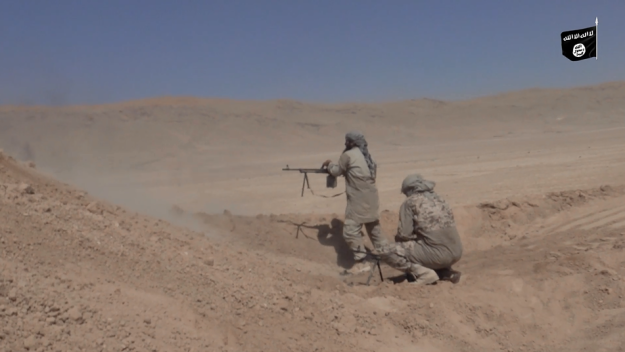By Kyle Orton (@KyleWOrton) on January 28, 2017

In his first speech as the then-Islamic State of Iraq’s (ISI’s) official spokesman in August 2011, Taha Falaha (Abu Muhammad al-Adnani) referred to several of the group’s “leaders” who had been killed. Among them was Abu Raghd, whose biography provides a glimpse of the role regional states—specifically Saddam Husayn’s Iraq and Bashar al-Assad’s Syria—played in facilitating the birth of the Islamic State (IS).
Abu Raghd—who also goes by Abu Raghd al-Jazrawi and Abu Raghd al-Utaybi—was a Saudi citizen and a veteran of the jihad against the Soviet Union’s occupation of Afghanistan. Abu Raghd founded the Faruq Camp in Rawa (hence it also being known as the Rawa Camp) in Iraq in June 2003. The Rawa Camp has become a staple of the historiography the IS movement tells, and tells itself, as the “starting point of the jihad in Iraq“.
Background
IS’s founder, Ahmad al-Khalayleh (Abu Musab al-Zarqawi), arrived in Baghdad in May 2002 with a number of senior jihadists, who were followed by a few-dozen more before the invasion began. Al-Zarqawi was “relatively free to travel within Iraq proper,” and soon moved to put together regional networks, in Lebanon and Syria specifically—Falaha himself being recruited in Aleppo during this time—before returning to Iraq in October 2002.
Abu Raghd’s story suggests that the “ratlines”—overseen by Bashar al-Assad’s military intelligence—that would later bring thousands of jihadists to IS to war against the Coalition and the elected Iraqi government had been activated somewhat earlier than is usually thought, since Abu Raghd had entered Iraq via Syria even before al-Zarqawi arrived in Iraq via Iran.
Rawa would become a salient node in the facilitation network that brought foreign volunteers to join IS during the U.S. regency in Iraq. Rawa is located in the north-west of Anbar Province along the Euphrates River Valley that leads to the Qaim/al-Bukamal crossing into Syria, one of the major gateways for the foreign jihadists in those years.
One of the facilitators in Rawa after the regime came down was Abu Dua, whom the U.S. mistakenly believed they had killed in October 2005. Likely Abu Dua, man from Samarra named Ibrahim al-Badri, had retreated into Syria, where the Assad regime provided safe-haven. Abu Dua would emerge later and become much better known as Abu Bakr al-Baghdadi.
Long before Abu Raghd’s arrival, Anbar had been a base for the training of Islamists. Just downriver in Heet, Sabri al-Banna (Abu Nidal), trained (p. 121) operatives of the Syrian Muslim Brotherhood during their revolt against Hafez al-Assad, which Saddam had supported (p. 148) from the very beginning.
Rawa Camp
An audiotape was posted on a jihadi website in April 2006 showing a man identified as Abu Muhammad al-Salmani, a jihadi commander, who described how the Faruq camp at Rawa had been modelled after its namesake in Afghanistan. “We first begun by gathering all the information we could … [and] read everything that has been written about the camp in Afghanistan,” al-Salmani said. “After the camp was set up, Muslims from everywhere started pouring in. … Afghan Arabs were the first to join the camp.” The training sessions lasted between thirty and forty-five days, al-Salmani said, adding—in typical phraseology—that Rawa “became the starting point of jihad in Iraq”.
The teachers at the Rawa camp included the most elite figures of the IS movement: Mustafa Ramadan Darwish (Abu Muhammad al-Lubnani), the first military leader who it seems formally oversaw the camp, Umar Hadid (Abu Khattab al-Ansari), Umar Yusef al-Juma (Abu Anas al-Shami), Abu Ibrahim al-Tunisi, Abu Tariq al-Yemini, and Abu Hammam al-Urduni.
Abu Raghd was killed in a U.S. airstrike on the Rawa Camp on 8 August 2003 that killed eighty jihadists, including Darwish’s son, Muhammad (Abu Suhayl), and a close friend of Darwish’s, Fadi Abu al-Dardaa, who travelled with Darwish to Iraq.
Pingback: The Islamic State Was Winning When We Thought It Was Losing | The Syrian Intifada
Pingback: A Turncoat Still Loved By the Islamic State: Manaf al-Rawi | The Syrian Intifada
Pingback: The Islamic State’s Profile of Umar Hadid | The Syrian Intifada
Pingback: The Leader of the Islamic State in the 2004 Fallujah Battles: Umar Hadid | The Syrian Intifada
Pingback: Islamic State Operative Connected to Charlie Hebdo Attack Might Still Be Alive | The Syrian Intifada
Pingback: American Sanctions Hit Islamic State’s Finances, Propaganda, and Terrorism | The Syrian Intifada
Pingback: One More Time on Saddam and the Islamic State | Kyle Orton's Blog
Pingback: Islamic State Profiles the Leadership - Kyle Orton's Blog